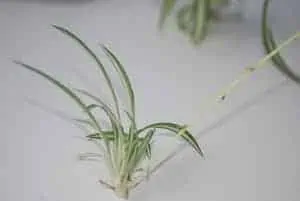If you’re looking for a great indoor plant, a spider plant (Chlorophytum comosum) is an excellent choice. It is easy to care for, requiring low maintenance, making it the perfect plant for even the most inexperienced plant connoisseur.
The only question that remains is how exactly do you take care of this tropical beauty?
To grow a spider plant, you will need moist but well-drained loamy soil, indirect exposure to sunlight, and moderate temperatures as well as humidity. Likewise, you will have to prune and replant the spider plant babies and apply fertilizer.
In this guide, we will cover everything you need to know about how to take care of a spider plant, from choosing the right growth requirements to effective spider plant propagation. So, let’s dive right in!
Table of Contents
Basic Requirements for Growing Spider Plants
Spider plants can thrive indoors provided that the optimum environmental conditions are set up. Addressing the basic requirements for these plants takes very little effort compared to growing other types of house plants. With that, here are the things you need to ensure to grow spider plants at home.
Well-Drained Sandy Loamy Soil
The best soil for spider plant growth is sandy, loamy soil with a porous attribute. By getting this type, the water gets quickly drained which protects your spider plant roots from rotting or any damage compared to when it’s planted on clay soil.
In the same way, your spider plant also remains hydrated all the time, primarily if you use a self-watering pot ideal for those who are frequently out of the house.
Find loamy soil with 30% compost to ensure the proper nutrients are present. If you’re looking for something specific, try the African Violet potting soil, which contains mixes of nutrients and texture. You can also consider other types with the same attributes like Miracle-grow.
Furthermore, make sure that its pH level is between 6 to 6.5, with 8 as its neutral ceiling value. If the soil is not neutral, it can have an adverse effect on nutrient absorption. For example, if you have highly acidic soil, your spider plant can experience iron deficiency, causing interveinal pale or yellowish leaves.
During winter, it’s vital to keep the soil dry in between watering, while during the summers, you can keep it slightly moist as the evaporation rate increases with increased heat.
Restricted Watering
Water dictates the survival of any plant. And in the case of spider plants, watering can make or break the roots. Therefore, it’s not recommended to water your spider plant every day as it could kill off the house plant. Instead, you should go for restricted watering.
How Often Should I Water a Spider Plant?
The ideal frequency of watering a spider plant is once a week. But before you proceed with putting water, you should check if the soil is dry. It is still moist, wait another day and check again.
If you live in an area that has higher temperatures, you might consider watering the spider plants twice a week. However, you should follow the same protocol, checking the amount of moisture first. Then, during colder seasons, you can reduce the frequency.
Indirect Light
Bright light can guarantee luscious spider plant growth. But you have to ensure that the plant is not directly exposed to light. Otherwise, the high intensity of the sunlight can cause damage to the leaves.
If you’re placing your spider plants outdoor, put them under an area where the sunlight won’t directly hit them. A shaded area where the light is not as intense is a crucial spider plant light requirement. On the other hand, if you have it inside, make sure the indirect light suffices.
Some homeowners prefer placing spider plants near the windows. But you have to be careful if you do exactly this, making sure that the sunlight is not too much. Put up a less sheer curtain to regulate the amount of sunlight entering the room or hang it at a level away from direct light.
Once you provide the ideal light for the spider plant, you’ll be delighted with the growth rate and the robust health your plant gains.
Moderate Temperature and Humidity
Despite the high tolerance of spider plants to various conditions, exposing them to extremely low temperatures affect their growth substantially.
The ideal living temperature for spider plants is between 70 to 90 degrees Fahrenheit. Any lower than this, significantly below 35 degrees, leads to slow or stunted growth.
In terms of humidity, spider plants also thrive best in a moderately humid environment between 40% to 80%. You can regulate this growing requirement by using humidity trays or in-room humidifiers.
How To Take Care of a Spider Plant
Setting up the growing requirements for a spider plant is so straightforward that anyone can do it within a short time. But although the effort needed to grow a spider plant is minimal, caring for this indoor gem long-term obliges habitual attention.
Still, it keeps up with its low maintenance reputation as the essential steps on how to take care of a spider plant are less demanding. Here are the tasks you can undertake to ensure proper spider plant care.
Choose the Right Pot
Spider plants are not so picky in terms of pot material. You can get plastic, ceramic, terracotta, wood, concrete, or fiberglass. The only thing you have to be critical about is whether or not there are enough drainage holes in the bottom.
Since the loamy soil ideal for spider plant growth allows water to flow downwards easily, it only makes sense to choose a pot with multiple holes. Otherwise, the water can quickly get stuck, causing damage to the roots of the spider plants.
In terms of size, go for a slightly bigger pot than the spider plant roots. With that, the size will generally depend on the plant size. But as a general rule of thumb, make sure it’s no more than two inches larger than the spider plant.
Keep the Soil Moist

You can purchase the item above from Amazon
You may already know by now that moisture level is critical for the health and growth of the spider plant. Keeping the soil moist means ensuring providing just enough water.
Overwatering is as dangerous as underwatering to any plant as a whole. So, with spider plants, you’ll want to make sure it’s completely dry before watering them substantially once a week. If you go against this recommended tip, you’ll be risking your spider plant to the following:
Overwatering
Watering your spider plant more than once or twice a week (depending on the environmental temperature) damages your spider plant, let alone watering it every day.
You’ll spot an overwatered spider plant easily as its leaves appear wilted, curled, soft, and yellowish. It has brown spots and tips. And if you look into its soil, you’ll notice it’s soggy and waterlogged. This could lead to fungal growth and worse, root rot which kills your spider plant.
Underwatering
While spider plants will remain alive and well in dry soil, it’s not going to be the same case if you neglect entirely to water them. If you want your indoor plant beauty to thrive, it’s always best to keep the soil moist. Otherwise, you may find your spider plant leaves falling off and drying up.
Consider watering your spider plant twice a week during the summers but only if the soil becomes drier than usual. The increased evaporations rate can cause dehydration, which harms your spider plant.
Moreover, it’s imperative to water your plant according to growth. For example, you may reduce your watering from every other five days to once a week as the spider plant turns a year old.
Prune From Time to Time
Spider plants have aesthetically pleasing features making them a fabulous house decor that provides bright and a close-to-nature atmosphere indoors. But you can’t expect spider plants to look how they are on their own.
Pruning is an important way to keep your spider plant neat and healthy. By removing the dead leaves, you protect the entire plant from any possible infection or further wilting. You also get to maintain its ribbon-like foliage.
Moreover, repotting the spiderettes ensures that the spider plant won’t have stunted growth.
Add a Fertilizer to the Spider Plant
If you want a more robust spider plant, adding fertilizers is an excellent way to go. Fertilizers can improve your plant’s growth making it more hardy and resilient from infection or infestation.

However, it’s best to understand how much and how frequently you should apply fertilizer to your plant. If you add too much fertilizer, you could potentially kill the spider plant. And if you add too little, you may find it futile as you’re not giving enough nutrients to make a difference to the spider plant’s health.
There are no specifics when it comes to the type of fertilizer for spider plants. You can use any fertilizer suitable for houseplants, whether granular-type release, all-purpose, water-soluble, or complete.
The best time to fertilize your spider plant is during the spring and summer. Do it twice a month for optimum growth.
How To Propagate New Spider Plants?
You can end up growing multiple spider plants over the years by simply repotting the hanging spiderettes. Planting spider plant babies provide more room for growth in the parent plant.
However, the more spiderettes there are, the more energy is needed, and therefore, keeping your spider plant away from having bushier foliage.
Propagating new spider plants couldn’t be more simple with these steps.
Check the spiderette’s for roots
It’s easy to spot the spiderette’s aerial roots. They go hand-in-hand with its full ribbon-like leaves hanging from the stem. Once you see that there are ample roots in the spiderette, it’s enough sign to proceed with repotting.
Clip the baby spider plant
Clip the spiderettes from the flower stalk near the aerial roots using your trimmer. Do this to the other baby spider plants for multiple propagations.
Prepare the pot with loamy soil
As you know by now, porous loamy soil accommodates spider plant growth. So, before deciding to repot, make sure to prepare the soil first in a pot with drainage holes and have them ready the moment you clip the spiderettes.
Plant the spiderette in the center
Once you clipped the baby spider plant, place it in the center of the pot to allow the roots the spread on the sides. Make sure the aerial roots are buried nicely, with the nodules touching the soil.
You can also choose to place the spiderettes suspended in water. This way, the roots will grow longer. However, there are cases wherein baby spider plants propagated in water for a long time have trouble adapting to the soil. Therefore, transfer the spiderettes to a soil-filled pot as soon as possible.
How Long Does It Take for Spider Plants To Root?
You can expect to see new spider plants root between 7 to 10 days of repotting. After a few weeks, you will also most likely notice new leaves growing from the repotted spiderettes. Keep the soil moist but not wet to ensure the spider plant grows healthy and beautifully.
Frequently Asked Questions About Spider Plant Care
How Often Should I Repot a Spider Plant?

Repotting the spiderettes should be as often as possible, especially if they come in large numbers. Otherwise, your parent spider plant may not reach its optimum growth.
Likewise, remove the spiderettes every time you prune to keep the plant more manageable and the foliage thicker.
On the other hand, a full-grown spider plant should be replanted or transferred to another pot once, every other year. This may depend on the size of the pot and the plant itself. You can easily decide to repot once you see the roots coming out of the bottom of the pot.
Spider plants grow incredibly fast. But if you don’t repot your spider plant, there’s a high chance that it will retain its size and seize to grow any further.
How To Clean Spider Plant Leaves?
People are often attracted to the spider plant leaves, hence, it only makes sense to put a bit of effort into cleaning them properly.
To do this, use a misting spray to dampen the long leaves. Then get a microfiber cloth to remove dust and insect remnants. Run the cloth from the top to the bottom of each leaf.
On the other hand, if the leaves are infested with insects and fungi, you can get rid of them by dipping a cotton ball in alcohol and gently rubbing it on the leaves.
Should I Cut the Brown Tips Off My Spider Plant?
You can choose to cut the brown tips if you like, especially if you’re conscious about how the spider plant should appear. But in many cases, it’s not necessary as the discoloration doesn’t pose any critical harm anyway. Eventually, the tips will dry off.
Meanwhile, if you want to prevent brown tips from forming, flush the soil where the spider plant is planted. This way, you remove the excess nutrients causing the brown tips.
Where Should You Place a Spider Plant?
The general rule of thumb when it comes to spider plant placement indoors is to always keep it away from direct sunlight.
You can put it near a window provided that the curtains are up. You can also have it hung on the wall or from the ceiling. Plus, you can opt to keep a small spider plant on your desk. You can even put it in your bedroom.
Having a spider plant around purifies the air. Hence, it’s a great indoor plant not just for aesthetic purposes.
Do Spider Plants Do Well in Bathrooms?
Yes, putting a spider plant in your bathroom can still thrive even when placed in the bathroom.
As they are low maintenance, requiring minimal light, and tolerating low humidity, you can expect a spider plant to grow without problems even in a cramped space such as a bathroom. Likewise, since spider plants clean the air, it helps keep the room free from impurities.
How Long Do Spider Plants Live?
You can keep a spider plant around for an astonishing 20 to 50 years, provided that you follow the steps on how to care for a spider plant. On top of that, you can propagate tons of baby spider plants.
You can gift them to your family and friends or sell them within your community. You will be surprised how a single spider plant can generate long-term income.
Conclusion
Spider plant indoor care is perhaps one of the easiest things you can undertake, as far as plant growth is concerned. But even with only a few demands on taking care of a spider plant, attention must be paid consistently if you’re aiming for aesthetically pleasing foliage.
Avoid underwatering and overwatering to prevent irreversible health damages such as root rotting, fungal infection, and aphids infestation.
With this guide, take the first few steps in growing your very own spider plant with confidence. In no time, you’ll get yourself plenty of baby spider plants to give to people around.
Recent Posts
Have you found yourself wondering, 'why is my bamboo growing so slow?' Despite the fact that bamboo plants are remarkably fast-growing, it can sometimes take months (or even years!) to see any signs...
Miracle-Gro is a huge help when you are trying to get decent yields out of your plants or if you want them to thrive. However, you may have noticed that a single dose of fertilizer does little to...
